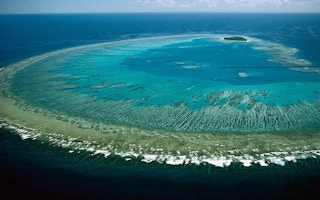We are currently in the midst of the the third and quite possibly worst global coral bleaching event in history, thanks to record high sea temperatures caused by a strong El Niño and climate change.
Scientists reported earlier this year that 99 per cent of 500 coral reefs surveyed in Australia’s Great Barrier Reef have been hit by the bleaching event, which has already impacted reefs across the Pacific, from American Samoa and Fiji to Hawaii and Vanuatu, as well as parts of the Caribbean, Florida Keys, and Indian Ocean.
For the first time ever, scientists have captured video of a coral reef bleaching, which occurs when waters that are warmer than normal cause coral to eject the algae that reside in their tissues and provide them with food as well as their vibrant colors.
But a new study published in the journal Science Advances has concluded that another impact of global climate change might help coral reefs survive increasing sea temperatures: “even a modest sea level rise can substantially reduce temperature extremes within tide-dominated reefs, thereby partially offsetting the local effects of future ocean warming,” the authors of the study write.
Rising levels of carbon dioxide in Earth’s atmosphere will cause significant changes to ocean temperatures and chemistry over the next 100 years, thereby increasing the frequency and severity of mass bleaching and other stresses on coral reefs and reef systems, scientists say. And temperature anomalies, thermal stresses, and the coral bleaching they provoke are often much more pronounced in shallow reef systems than in the surrounding ocean.
“
Temperature is widely recognised as a key environmental driver of reefs and temperature extremes are known to be one of the key stressors to coral reef communities around the world.
Ryan Lowe, lead researcher, University of Western Australia
The University of Western Australia’s Ryan Lowe led a team of researchers who studied a reef system off the coast of northwestern Australia, as well as other reef systems across the globe, in order to develop a new model for predicting how rapid sea level rise will impact daily water temperature extremes within these shallow reefs over the next century.
“Temperature is widely recognised as a key environmental driver of reefs and temperature extremes are known to be one of the key stressors to coral reef communities around the world,” Lowe said in a statement.
But because temperatures in shallow reef systems often differ from the surrounding ocean, predicting future patterns of bleaching and other stresses in those reefs depends on accurately predicting reef environments. Yet most research in the field has focused on improving predictions of regional ocean warming driven by long-term climate change and short-term climate patterns like the El Niño-Southern Oscillation cycle.
That means that scientists currently lack the ability to predict the impacts of rising sea levels across a number of reef systems, especially reef habitats with significant tidal exposure.
Lowe and team used detailed field measurements of hydrodynamics, water temperature, and air-sea conditions of tide-dominated reef habitats to construct a modeling framework for predicting how local temperature extremes in shallow reefs will change in the future based on local tidal conditions, solar heating properties, and reef structures.
They found that an atmospheric exchange of surface heat drives the greatest temperature fluctuations in reefs located in shallow, low-tide waters. Lowe said his team’s field studies revealed extreme temperature fluctuations in the reefs off Australia’s Kimberley coast.
Temperatures varied more than 10-degrees-Celsius over a single tidal cycle and became most extreme when the low tide period aligned with maximum heating by the sun at noon, which warmed the shallow water on the reefs.
That means that rising sea levels could reduce local reef water temperatures by a substantial amount, helping protect them from becoming stressed and bleaching as a consequence.
“These temperatures are particularly extreme in regions when the tidal range is large when compared to the water depth over a reef, which can cause shallow water to ‘pond’ within reefs for extended periods of time each day,” Lowe said. “So even a modest rise in sea level could help lower the water temperature of the reef and may also partially reduce reef heat extremes in the world’s warming oceans.”
This story was published with permission from Mongabay.com

















